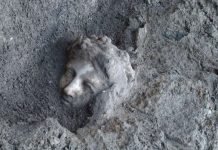
It’s sometimes hard to remember that meteorites have been hitting our planets for millions of years.
And some of them are made of valuable materials such as titanium or iron.
So, theoretically, at least, our bronze and iron age ancestors could utilize these ready-made metallic rocks without having to dig underground to access them, like they would with regular tin or iron veins.
Now, a new study of an arrowhead made out of a meteorite points out just how valuable iron age society thought these meteorites were and hints at a trade network that reached farther than archeologists initially thought.
While it might not surprise archeology fans, it might come as a bit of a surprise that dozens of documented objects made out of meteorites are found at archeological digs.
However, most objects were found in the Middle East and Asia.
Europe, the home of what we now consider a “Western” society, only had two sites in Poland that turned up objects made by meteorites.
Now, there is a third. An arrowhead found in a dwelling near Lake Mörigen in Switzerland in the late 19th century was confirmed to be made from a meteorite.
It was dated back to the Bronze Age, somewhere between 900-800 BCE. But several key features about it make it particularly interesting to archeologists.
First is how the researchers, led mainly by a Swiss team of academics, determined that this arrowhead was made of meteorite. They turned to modern-day analysis techniques that engineers call Non-Destructive Testing (NDT).
Typically, if an archeologist wants to determine whether a particular piece was made out of a meteorite, they would take a piece of it and subject it to destructive testing. The Swiss team took a gentler approach, subjecting numerous samples of collected archeological objects to different NDT techniques ranging from muon-induced X-ray emission spectroscopy to high-sensitivity gamma-ray spectroscopy.
Of all the samples they looked at, though, only one appeared to be from a meteorite. Strangely, it didn’t seem to be local.
In fact, they were initially looking for objects of possible meteoritic origin in that part of Switzerland because there had been a known meteorite strike known as the Twannberg iron meteorite that fell nearby.
When the Twannberg meteorite fell, it broke into pieces. So far, 2000 individual pieces have been found with a total weight of over 150 kg.
That’s a lot of easily recoverable metal sitting only a few kilometers from the site at Lake Mörigen, where the arrowhead was found. But strangely, the study found that the arrowhead was conclusively not made of the meteor that fell new Twannberg.
Instead, they believe it was created using pieces from a different meteorite that fell in Estonia in 1500 BCE. Known as the Kaalijarv meteorite, it is the best fitting of the three other meteorites with the same chemical signature as the arrowhead.
However, its landing site was over 1600 km away. That is quite the distance for an arrowhead to travel in the Bronze Age.
There are, of course, other explanations. Maybe another undiscovered meteorite with the same composition landed closer to Switzerland.
Or perhaps the other two meteorites that landed in Europe – one in the Czech Republic and one in Spain – could be the original source.
But it still seems surprising that the arrowhead wouldn’t have been made out of the local meteorite source only a few kilometers away and totaled more mass than a hunter would even use for arrowheads in their lifetime.
Unfortunately, this will most likely remain a mystery as to why this particular arrowhead has the composition it does.
But the high-tech techniques used by the researchers pave the use of such techniques for future meteoritic searches of archeological artifacts. Maybe they’ll find something even further afield than they have now.
Follow us on Twitter for more articles about this topic.
Written by Andy Tomaswick, Universe Today.




